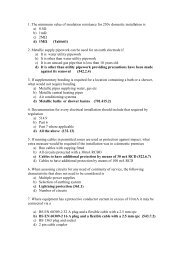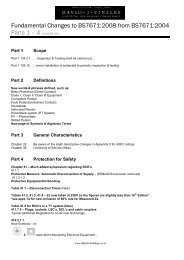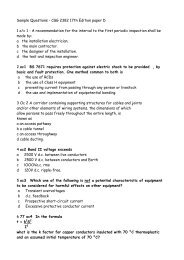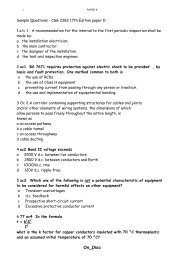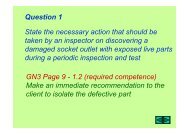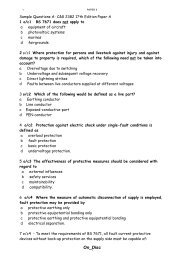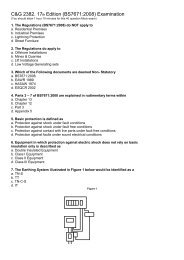a guide to fire detection and alarm systems 1
a guide to fire detection and alarm systems 1
a guide to fire detection and alarm systems 1
You also want an ePaper? Increase the reach of your titles
YUMPU automatically turns print PDFs into web optimized ePapers that Google loves.
A GUIDE TO FIRE<br />
DETECTION AND<br />
ALARM SYSTEMS<br />
A Fire <strong>detection</strong> <strong>and</strong> <strong>alarm</strong> ( FD+a ) system is what most<br />
workplaces <strong>and</strong> public accessed buildings have in place. The<br />
FD+a system has two primary functions <strong>and</strong> depending on<br />
how it is designed, Protect the life within the building, giving<br />
the occupants sufficient warning of an outbreak of <strong>fire</strong>, so they<br />
can evacuate safely <strong>and</strong> Protect the building <strong>and</strong> its contents<br />
by summoning the Fire Brigade at the earliest opportunity.<br />
Systems designed <strong>to</strong> protect life are know as Category L.<br />
Systems designed <strong>to</strong> protect the Building are known as Category P <strong>systems</strong>.<br />
Some smaller buildings may not have or need an FD+a system, for example a small<br />
open plan area where someone shouting “<strong>fire</strong>” can be heard all around.<br />
The decision on what Category is required for any building is done on the basis of a<br />
Fire Risk assessment which identifies hazards, who might be in danger <strong>and</strong> what<br />
would happen as a result of the hazard. This involves consultation with the local Fire<br />
authorities, building control, Insurers <strong>and</strong> consultants.<br />
There are many fac<strong>to</strong>rs in the decision of the Category required. A building may<br />
have sensitive equipment, documents or valuable contents which if damaged or lost<br />
by <strong>fire</strong> would be a severe disruption <strong>to</strong> that business/building. In this case a P system<br />
would be asked for.<br />
The building may have elderly occupants in which case a Category L system would<br />
be asked for, <strong>to</strong> protect the life of everyone in the building.<br />
Another important fac<strong>to</strong>r now with the planning of a system is <strong>to</strong> consider the<br />
Disability Discrimination Act (DDA).<br />
This requires for a system <strong>to</strong> give the same level of warning <strong>to</strong> a Deaf Person, as it<br />
would for a person with normal hearing. It is down the building’s owner <strong>to</strong> decide if<br />
Deaf people will work or stay in his property.
Buildings such as hotels should have visual <strong>alarm</strong>s throughout <strong>and</strong> tactile <strong>alarm</strong>s ( a<br />
small vibrating unit that goes under a pillow) in rooms of sleep. This can be very<br />
costly <strong>to</strong> install visual <strong>alarm</strong>s in every area of as building, so a specialist pager<br />
system is another option.<br />
The Fd+a <strong>systems</strong> are based on two technologies <strong>and</strong> will basically feature<br />
au<strong>to</strong>matic <strong>fire</strong> detec<strong>to</strong>rs ( AFD ) such as a smoke detec<strong>to</strong>r <strong>and</strong> manual call points (<br />
MCP ) commonly known as a break glass unit. Where a system has no AFD but<br />
MCP’s only this is known as a category M.<br />
FD+A <strong>systems</strong> should be installed <strong>and</strong> maintained in accordance with British<br />
St<strong>and</strong>ard 5839 part 1.<br />
Non–Addressable<br />
The basic technology is Non–Addressable which is found more often in smaller<br />
buildings due <strong>to</strong> it being more cost effective. A non-addressable system is simply<br />
comprised of Fire zones. These are represented by red l.e.d.s on the control panel.<br />
Faults use amber l.e.d.s.<br />
A zone is how a building is split up <strong>to</strong> speed the location of a <strong>fire</strong>. For example if a<br />
building was not zoned then in the case of a <strong>fire</strong>, the whole building would have <strong>to</strong> be<br />
searched instead of being directed <strong>to</strong> the exact zone area by the control panel. This<br />
would dramatically slow up the location process <strong>and</strong> would result in more damage<br />
<strong>and</strong> possibly loss of life.<br />
Each zone is made up of a grouping of AFD <strong>and</strong> MCP’s <strong>and</strong> in the event of a <strong>fire</strong><br />
being detected either au<strong>to</strong>matically by AFD of manually by a person discovering a<br />
<strong>fire</strong> <strong>and</strong> operating the MCP, will cause the control panel <strong>to</strong> enter <strong>fire</strong> condition which<br />
will then operate the <strong>alarm</strong> sounders thus alerting the occupants.<br />
The Zone in <strong>fire</strong> condition would then have <strong>to</strong> be checked <strong>to</strong> establish the exact<br />
detec<strong>to</strong>r that caused the <strong>alarm</strong>. If an AFD was the cause a red l.e.d would be<br />
illuminated on the detec<strong>to</strong>r itself.<br />
The zone wiring is in a redial circuit <strong>and</strong> terminated with an end of line device or<br />
resis<strong>to</strong>r which enables the panel <strong>to</strong> moni<strong>to</strong>r the wiring for short <strong>and</strong> open circuit
faults.<br />
When a smoke detec<strong>to</strong>r enters <strong>fire</strong> condition it draws much more current than normal<br />
which is sensed by the <strong>alarm</strong> panel <strong>and</strong> it turn enters <strong>fire</strong> condition. A MCP is a<br />
simple switch between positive <strong>and</strong> negative which under normal condition is open<br />
circuit but when a glass is broke goes closed. A resis<strong>to</strong>r in series with the positive<br />
prevents this being a complete short circuit but again causes a surge in power as<br />
with the smoke detec<strong>to</strong>r.<br />
The panel will typically have two on board <strong>alarm</strong> sounder circuits which in normal<br />
operation send a reversed voltage down each circuit <strong>to</strong> moni<strong>to</strong>r for faults. The<br />
voltage is reversed otherwise the sounders would be on constantly but is changed <strong>to</strong><br />
normal polarity in a <strong>fire</strong> condition.<br />
The panel requires a dedicated 240v ac supply <strong>and</strong> where it is then reduced down<br />
through a transformer <strong>and</strong> then changed <strong>to</strong> its operating voltage of 24 volts DC via a<br />
bridge rectifier.<br />
As the system operates on DC it can now be battery backed up so in the event of a<br />
power failure it will continue <strong>to</strong> provide cover from 24 hours up <strong>to</strong> 72 depending on<br />
it’s Category.<br />
The batteries in the <strong>fire</strong> panel should be replaced at least every 4 years or when<br />
testing dictates.<br />
In this system the physical wiring dictates the zoning <strong>and</strong> the detec<strong>to</strong>r decides if it’s a<br />
<strong>fire</strong> condition or not.<br />
Analogue Addressable:
The second technology is far more advanced <strong>and</strong> is normally found in the larger<br />
premises. This is called Analogue Addressable <strong>and</strong> will pin point the exact location of<br />
a <strong>fire</strong> through zoning <strong>and</strong> also the detec<strong>to</strong>r in <strong>fire</strong> having it’s own number (address)<br />
<strong>and</strong> text allocated <strong>to</strong> it.<br />
This system is wired in a loop <strong>and</strong> unlike the non addressable the zoning is done<br />
through programming, so the same cable can pass through the whole building. A<br />
typical loop can have up <strong>to</strong> 126 devices which are constantly tested by the control<br />
panel. On this system should a part of the loop wiring become damaged short circuit<br />
isola<strong>to</strong>rs ( SCI ) either side of the fault will shut down that particular section of wiring<br />
<strong>and</strong> continue <strong>to</strong> operate with the reminder of the wiring <strong>and</strong> devices. Again unlike the<br />
non addressable which would loose the zone in fault.<br />
When a detec<strong>to</strong>r on the loop senses a <strong>fire</strong>, information is passed back <strong>to</strong> the control<br />
panel which is then processed <strong>and</strong> a decision is made by the panel not the detec<strong>to</strong>r<br />
whether it is a <strong>fire</strong> or not. Unlike the non addressable system each detec<strong>to</strong>r or MCP<br />
reports it analogue value back <strong>to</strong> the control panels front end processor ( FEP ). The<br />
device reports back whether it’s in a pre-<strong>alarm</strong>, <strong>alarm</strong> or fault state by differing<br />
analogue values. Under normal conditions the levels are low but if smoke enters the<br />
detec<strong>to</strong>r chamber the level will rise until it reaches a predetermined threshold <strong>and</strong><br />
enters <strong>fire</strong> condition.<br />
Individual detec<strong>to</strong>rs can have their threshold levels altered so for example can be<br />
less sensitive during the day <strong>and</strong> more at night if required. Another advantage it has<br />
over non addressable technology is that individual detec<strong>to</strong>rs can be isolated instead<br />
or an entire zone. This system can dramatically reduce unwanted <strong>alarm</strong>s <strong>and</strong> unlike<br />
non addressable will let the user aware if a detec<strong>to</strong>r has become faulty.<br />
In the event of a <strong>fire</strong> or fault the control panel offers text description of the condition,<br />
unlike the non addressable which will only illuminate relevant led’s. This make the<br />
location of <strong>fire</strong> <strong>and</strong> faults much quicker.<br />
The panel operates on the same voltage as the non addressable <strong>and</strong> also has<br />
battery back up.<br />
As with both non addressable <strong>and</strong> addressable all wiring must be in <strong>fire</strong> resistant<br />
cable.<br />
There is also wire free radio based analogue addressable <strong>fire</strong> <strong>systems</strong> which have<br />
all the benefits of a hard wire system but with the obvious advantage of no cabling<br />
required <strong>to</strong> all the devices. This is an ideal option for listed buildings such as<br />
Churches, where cable runs would look unsightly. There is also no damage <strong>to</strong> the<br />
building or mess from drilling. Installation is far quicker <strong>and</strong> far less labour intensive<br />
but has the drawback of having <strong>to</strong> replace every battery in each device<br />
approximately every 5 years. The equipment is more expensive than hard wired but<br />
on the larger installations the reduction in labour costs can be balanced against the<br />
cost of hardwired.<br />
Both addressable <strong>and</strong> non addressable use devices which are designed <strong>to</strong> detect<br />
<strong>fire</strong>s <strong>and</strong> give audible warning.
These are:<br />
Smoke detec<strong>to</strong>rs:<br />
The smoke detec<strong>to</strong>r has a few variations such as Optical, ionization, aspirating<br />
smoke detec<strong>to</strong>r ( ASD ) <strong>and</strong> modern combined smoke <strong>and</strong> heat. Optical is the most<br />
widely used <strong>and</strong> is more suited <strong>to</strong> detecting a slow burning <strong>fire</strong> which gives off larger<br />
smoke particles. Ionisation which are beginning <strong>to</strong> be phased out detect a quick<br />
burning <strong>fire</strong> which generates more heat <strong>and</strong> thinner smoke particles. The Aspirating<br />
smoke detec<strong>to</strong>r draws air from an area via a network of pipes which have sampling<br />
holes. The ASD can detect very small amounts of smoke <strong>and</strong> has a high sensitivity.<br />
The smoke is drawn through the holes in the pipes <strong>and</strong> back <strong>to</strong> a central aspirating<br />
detec<strong>to</strong>r. This is a common choice for areas such as computer suites,<br />
telecommunication room’s etc where the earliest possible warning of a <strong>fire</strong> is crucial<br />
<strong>to</strong> protect such sensitive equipment.<br />
The combined detec<strong>to</strong>r looks for both heat <strong>and</strong> smoke, this is seen as a replacement<br />
for the ionization detec<strong>to</strong>r. Some panels can be programmed <strong>to</strong> make a combined<br />
detec<strong>to</strong>r a heat during the day <strong>and</strong> smoke at night time.<br />
Manual Call Points:
The red box on the wall that everyone is familiar with. In the event of a <strong>fire</strong> a person<br />
would break the glass in the unit which in turn activates the <strong>fire</strong> <strong>alarm</strong>. Most<br />
commonly found at all exits <strong>to</strong> the outside of a building.<br />
Heat Detec<strong>to</strong>r:<br />
Comes in two variants <strong>and</strong> are most commonly found in kitchens, boiler rooms or un<br />
clean environments. They come as Rate of Rise which detects a rapid increase in<br />
temperature or fixed temperature which will only activate after the room temperature<br />
exceeds a pre determined temperature set in<strong>to</strong> the detec<strong>to</strong>r.<br />
Sounder:<br />
Normally red <strong>and</strong> alerts occupants audibly <strong>to</strong> a <strong>fire</strong>. These can be supplemented by<br />
visual <strong>alarm</strong>s ( flashing beacons ) where areas can be normally noisy i.e. fac<strong>to</strong>ries or<br />
DDA compliance. General sound level required is 65 DBa or 75 DBa in a room of<br />
sleep at bed head level. The sounder can also be integrated with a smoke or heat<br />
detec<strong>to</strong>r making it an ideal option for bedrooms where the owner might not want <strong>to</strong><br />
see a red sounder on the wall.
Beam Detec<strong>to</strong>r:<br />
Normally used in large areas such as warehouses. The beam detec<strong>to</strong>r can emit a<br />
beam reaching up <strong>to</strong> 100m in length from one end of a building <strong>to</strong> the other <strong>and</strong> can<br />
cover 1500m2 with a single unit. The beam is optical <strong>and</strong> when obscured by smoke (<br />
obscuration ) will activate the <strong>fire</strong> <strong>alarm</strong>.<br />
A wall mounted transmitter can be mounted up <strong>to</strong> 25m high (or 40m in P <strong>systems</strong><br />
with Fire Brigade response time is within 5 minutes). This emits a beam <strong>to</strong> another<br />
wall mounted receiver at the other end of the building or a reflective plate which<br />
bounces the beam back <strong>to</strong> the other unit.<br />
All <strong>fire</strong> <strong>systems</strong> must be regularly tested <strong>and</strong> maintenance is essential as it will<br />
prolong the life of a system <strong>and</strong> discover any faults that may occur. A system that is<br />
not maintained cannot be guaranteed <strong>to</strong> protect life <strong>and</strong> property



